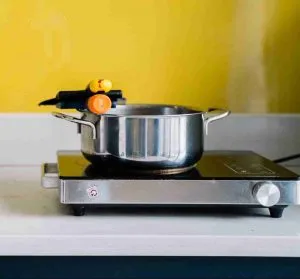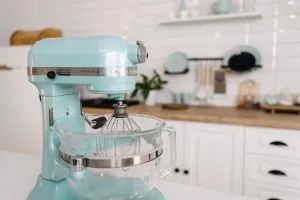Contents
ToggleA Tale of Two Neighbors
Let’s take a stroll down Maple Street, where our friendly neighbors, Sarah and Paul, live. Sarah, a culinary enthusiast, dreams of a new, wider sink to accommodate her massive pots and pans. Paul, on the other hand, a minimalist at heart, desires a sleek, undermount sink to match his modern kitchen design. But they both stumble upon the same question: how to measure kitchen sink?
The story of Sarah and Paul is quite common. So, let’s walk together through this measuring journey and help our friends find their dream sink.
Gather Your Tools

A craftsman is only as good as his tools. So, make sure you have a tape measure, a piece of paper, and a pen. You might also need a level, but that’s optional.
Step 1: Measure the Sink Length
Start by measuring from left to right, from the outer edge to the outer edge of the sink. Keep your tape measure flat against the sink to ensure accuracy. This measurement is your sink length. Write it down – you wouldn’t want to forget it later.
Step 2: Measure the Sink Width
Next, measure from front to back, again from the outer edge to the outer edge. That’s your sink width. It’s crucial as it helps determine if your sink will comfortably fit within your counter space, regardless of whether you’re eyeing a drop-in, undermount, farmhouse apron front, freestanding, or wall mount sink.
Step 3: Measure the Sink Depth
Now, measure from the top edge of the sink down to the bottom of the sink basin. This measurement is the sink depth, which helps you figure out how much vertical space your sink will take up. The shape of your sink – oval, neo-angle, rectangular, square, or round – can also influence its depth.
Step 4: Measure the Drain Hole
Last, but not least, measure the diameter of the drain hole. While most are standard, it never hurts to double-check. This ensures your new sink will be compatible with your existing plumbing fixtures, regardless of whether your sink is acrylic, ceramic, copper, cast iron, granite composite, or stainless steel.
Consider the Hole Count and Sink Rim Type
Don’t forget about the hole count and sink rim type. Sinks come with 1, 2, 3, or more holes for faucets and accessories. Depending on your sink type, it may be self-rimming or have no rimming at all, which can affect installation and the overall look.
A Word on Sink Types and Materials
Remember, the type and material of the sink you want also influence your measuring process. For instance, an under-mount sink will require different measurements than a top-mount or farmhouse sink. Similarly, a heavy cast iron sink may require additional support compared to a lighter acrylic model.
The Aftermath of the Sink-curiosity
After taking all these measurements and considering their options, our friends on Maple Street are ready to shop. Susan’s eyes light up as she spots a deep, wide, rectangular, cast iron farmhouse sink perfect for her cooking adventures, while Pete is thrilled to find a sleek, under-mount, stainless steel sink that fits his modern kitchen like a glove. They both made sure to consider the hole count and rim type to ensure a perfect fit.
A Happy Kitchen is a Happy Home
The journey doesn’t stop here. Maintaining your kitchen is as important as setting it up. For instance, the occasional leaky faucet is a common issue that can be fixed by following this guide on how to fix a leaky faucet.
Moreover, you can keep your tiles sparkly clean without any laborious scrubbing. Check out this fantastic guide on how to clean shower tiles without scrubbing. And if you’re dealing with pesky mold on your bathroom ceiling, you’ll find this ”how to get rid of mold in bathroom ceiling” article helpful.
Common Mistakes to Avoid While Measuring a Kitchen Sink
Measure twice, cut once – or so the old saying goes. This wisdom couldn’t be more true when measuring a kitchen sink. Even a slight miscalculation can lead to unexpected renovation headaches. Here are some common mistakes to watch out for:
Not Considering the Space for the Faucet
While focusing on the sink, it’s easy to forget about the space needed for the faucet. Faucets need ample room, not just for installation, but also for comfortable use. When measuring, ensure there’s enough space behind the sink for your faucet and that it won’t interfere with any window sills or backsplashes.
Forgetting the Under-Cabinet Space
Your sink needs to fit inside your cabinet too! Overlooking the under-cabinet space is a common mistake that can lead to serious fitting issues. Always remember to measure the inside of your base cabinet from left to right to ensure your sink will fit comfortably.
Ignoring the Backsplash
Backsplashes can limit the space available for your sink and faucet setup. When measuring, consider the height and depth of your backsplash to ensure it won’t interfere with your sink or faucet.
Diving Deeper: Different Types of Kitchen Sinks

Understanding the various kitchen sink types, their unique measuring requirements, and specific features will help you find the perfect fit for your kitchen. Let’s delve into some popular types:
Top-Mount Sinks (Drop-In)
Top-mount sinks, also known as drop-in sinks, are designed to drop into a hole cut out of your countertop. When measuring for a top-mount sink, you need to consider the size of the cut-out rather than the overall counter space. Make sure the lip of the sink, which rests on the countertop, has enough surface area to sit securely.
Undermount Sinks
Unlike top-mount sinks, undermount sinks are installed beneath the countertop, providing a seamless look. For these sinks, it’s important to measure the interior width of your cabinet, as the sink needs to fit within this space. Also, ensure there’s sufficient room for the sink clips required for installation.
Farmhouse Sinks (Apron-Front)
Farmhouse or apron-front sinks have a forward-facing section that protrudes beyond the edge of the countertop. These sinks require a special base cabinet and countertop cut-out. When measuring for a farmhouse sink, take into account the height, width, and depth of the sink, as well as the size of the cabinet it will rest on.
Freestanding Sinks
Freestanding sinks are standalone units that don’t require a countertop or cabinet for installation. Measure the floor space where you plan to install the sink, ensuring there’s enough room for plumbing connections and easy access.
Wall-Mount Sinks
Wall-mount sinks are attached directly to the wall, which frees up floor space. When measuring for a wall-mount sink, consider the height at which it will be installed and make sure there’s enough space for the sink’s width and depth.
Beyond sink types, other factors like shape, material, hole count, and rim type will also influence your decision:
Sink Shapes
Kitchen sinks come in various shapes, such as oval, neo-angle, rectangular, square, and round. Choose a shape that complements your kitchen’s design and consider how the shape might affect the sink’s depth.
Sink Materials
Kitchen sinks are made from a variety of materials, including acrylic, ceramic, copper, cast iron, granite composite, and stainless steel. Each material has its unique characteristics, such as durability, weight, heat resistance, and aesthetics.
Hole Count
Sinks come with 1, 2, 3, or more holes for faucets and accessories. Determine the number of holes you need based on the fixtures you plan to install.
Sink Rim Type
Different sink types have various rim styles, such as self-rimming or no rimming. The rim style can affect installation and the overall look of your sink.
Remember, each type of sink has its unique considerations when it comes to measurement and features. Taking the time to understand these requirements will ensure your new sink fits perfectly in your kitchen.
Perfect Sink: A Click Away!
Now that you’re well-versed in kitchen sink measurements, types, shapes, materials, and more, it’s time to find the perfect sink that matches your style, needs, and budget. Here are some top kitchen sink brands that promise quality, durability, and design.
Kohler: Timeless Design Meets Innovation
If you’re looking for a sink that blends timeless design with innovative functionality, Kohler is your go-to brand. With a vast range of materials, shapes, and types—from undermount stainless steel sinks to cast iron farmhouse models—Kohler offers exceptional durability and style. Check out the Kohler Whitehaven Farmhouse Sink with its classy design and easy-to-clean enamel finish.
Top | KOHLER K-5665-0 Whitehaven Farmhouse Sink | CHECK PRICE |
 | KOHLER Prolific 29 inch Workstation Stainless Steel Single Bowl Kitchen Sink with included Accessories, 10 inches deep, 18 gauge | CHECK PRICE |
 | KOHLER Task Kitchen Sink, Stainless Steel Dual Mount Single Bowl, 33" Workstation | CHECK PRICE |
Blanco: Stylish Sinks for Modern Kitchens
Blanco is renowned for its high-quality, stylish sinks designed for modern kitchens. Their granite composite sinks, such as the Blanco DIAMOND SILGRANIT Sink, are particularly popular for their heat, scratch, and stain resistance—perfect for busy kitchens!
Top | BLANCO, Anthracite DIAMOND SILGRANIT Drop-In or Undermount Sink | CHECK PRICE |
 | BLANCO, Anthracite DIAMOND SILGRANIT Super Single Drop-In | CHECK PRICE |
 | BLANCO Precis Bar/Prep Sink | CHECK PRICE |
Ruvati: Combining Luxury with Practicality
Ruvati effortlessly marries luxury with practicality. Their stainless steel sinks are known for their robust construction and sleek design. The Ruvati Workstation Sink comes with a built-in cutting board, roll-up rack, and colander, making food prep a breeze!
Top | Ruvati 32-inch Workstation Ledge Undermount 16 Gauge | CHECK PRICE |
 | Ruvati 32-inch Undermount 16 Gauge Tight Radius | CHECK PRICE |
 | Ruvati 15 x 15 inch Workstation Drop-in | CHECK PRICE |
Kraus: Quality You Can Trust
Kraus offers an extensive range of high-quality kitchen sinks, suitable for all styles and budgets. The Kraus WORKSTATION Sink is a customer favorite, boasting thick stainless steel construction and NoiseDefend soundproofing for a quieter kitchen.
Remember, the perfect kitchen sink isn’t just about the measurements. It’s also about choosing a brand that aligns with your kitchen style, functionality, and budget. Happy sink shopping!
Top | KRAUS Kore 36 Inch Undermount Workstation 16 Gauge | CHECK PRICE |
 | Kraus KWT310-33/PGM Kore Workstation 33 inch Topmount Drop-In 16 Gauge | CHECK PRICE |
 | Kraus Quarza Kitchen Sink | 33-Inch 60/40 Bowls | Brown Granite | CHECK PRICE |
The Art of Matching: Sink, Countertop, and Kitchen Style
The kitchen sink is more than a utilitarian feature; it’s a key piece of your kitchen’s aesthetic. When choosing a sink, it’s crucial to consider how it will blend with your countertop and overall kitchen style.
Sink and Countertop Harmony
Your sink and countertop should coexist harmoniously. For instance, undermount sinks pair beautifully with solid surface countertops like granite or quartz, offering a sleek, continuous line. Top-mount sinks, on the other hand, work well with almost any countertop material, including laminate, as the lip of the sink covers the countertop edge.
Sink Style and Kitchen Theme
When it comes to style, your sink should reflect your kitchen’s theme. A farmhouse sink might be the perfect fit for a rustic, country-style kitchen, while a sleek undermount sink could complement a modern, minimalist design.
Ultimately, a well-matched sink and countertop can elevate your kitchen’s aesthetic and functionality. So, take the time to consider your options and find the perfect pair.
Potential Issues Related to Sink Installation
When it comes to installing a kitchen sink, accurate measurements are only the first step. Overlooking potential installation issues can lead to problems down the road. Here are a few to keep in mind:
Sink Too Large or Small for the Space
If your sink is too large for your cabinet or countertop, you might have to cut into your cabinets or even replace them. On the flip side, a sink that’s too small may leave unsightly gaps or may not function as well as you’d like. Always double-check your measurements before purchasing a sink to avoid these issues.
Incorrect Measurements Leading to Leakage
Incorrect measurements can lead to improper installation, which in turn can cause water leakage. Water can seep through gaps between the sink and countertop, damaging your cabinets and floors. To prevent this, ensure your sink fits snugly in its space and is properly sealed.
Damage During Installation
Sinks can be heavy, and if mishandled, they can damage your countertop, especially if it’s made of a delicate material like marble or quartz. Always use caution during installation, and consider hiring a professional if you’re unsure.
As the saying goes, “An ounce of prevention is worth a pound of cure.” By considering potential issues during the planning stage, you can ensure a smooth and successful sink installation.
FAQ:
How do you measure a kitchen sink for replacing?
Start by measuring the length and width of your current sink from edge to edge. Then, measure the depth from the top edge down to the drain. If you have a top-mount sink, also measure the countertop cut-out. Finally, measure the size of the drain hole. These measurements will guide you in finding a replacement sink that fits your existing setup.
How do I know what size my sink is?
You can determine the size of your sink by measuring its length, width, and depth. Use a measuring tape to get the dimensions from the left edge to the right edge for length, the front edge to the back edge for width, and from the top edge to the drain for depth.
Where are kitchen sinks measured?
Kitchen sinks are measured from edge to edge for length and width, and from the top edge to the drain for depth. If you’re measuring for a top-mount sink, you’ll also need to measure the countertop cut-out. Remember, all measurements should be taken from the inside of the sink to get accurate dimensions.
What is the standard size of a kitchen sink?
The standard size of a kitchen sink typically ranges from 22 to 33 inches in length, 19 to 24 inches in width, and 8 to 10 inches in depth. However, the size can vary based on the style of the sink and the space available in your kitchen. Always measure your existing sink and kitchen space before making a purchase.
What if my sink has two or three bowls?
If your sink has multiple bowls, measure each one separately. They may be the same size, but often they are not. Record the length, width, and depth for each bowl. Don’t forget to measure the distance between the bowls as well, as this can be important for fitting accessories like faucets or soap dispensers.
How do I measure the faucet hole?
Faucet holes are typically a standard size, but it’s always good to measure to be sure. You can do this by removing the faucet and measuring the diameter of the hole directly, or if this isn’t possible, you can estimate by measuring the base of the faucet.
What if my measurements are between standard sink sizes?
Always go for the smaller size when your measurements are between standard sizes. It’s easier to adjust the cut-out in your countertop to fit a slightly smaller sink than it is to make a larger sink fit into a space that’s too small.
How do I ensure that my sink matches my kitchen style?
Consider the material and design of the sink. Stainless steel sinks, for instance, suit modern kitchens, while ceramic sinks complement traditional or farmhouse-style kitchens. Your sink should also match the fixtures and appliances in your kitchen for a cohesive look.
What should I do if my sink doesn’t fit?
If your new sink doesn’t fit, it’s best to consult with a professional. They can help adjust your cabinets or countertops to accommodate your sink. Always remember, accurate measurements at the start can save you from these troubles.
Wrapping It Up
And there you have it – a comprehensive guide on how to measure a kitchen sink! From understanding the importance of accurate measurements to exploring various sink types, materials, and top brands, we’ve walked through the entire journey together.
Remember, measuring a kitchen sink isn’t a task you do every day, but when the time comes, it’s crucial to do it right. Armed with this knowledge, you can now confidently measure your kitchen sink, whether you’re replacing an old one, renovating your kitchen, or building a new home.
Don’t forget, your kitchen sink is more than just a functional element. It’s an integral part of your kitchen’s aesthetics, influencing your space’s overall look and feel. So, choose wisely, measure carefully, and install correctly.
Additional Reading
For more helpful tips and guides, check out the following articles:
- How to Unclog a Toilet When Nothing Works: Struggling with a stubbornly clogged toilet? Learn effective techniques to tackle even the toughest clogs.
- How to Turn Off Water to Toilet: Discover the easy steps to safely shut off the water supply to your toilet when dealing with leaks or repairs.
- Disinfect Carpet Without a Steam Cleaner: Keep your carpets clean and germ-free without a steam cleaner using these simple, cost-effective methods.
- The Right Drill Bit for Screw Size: Unsure which drill bit to choose? Our guide helps you select the perfect drill bit for your screw size and project needs.























































